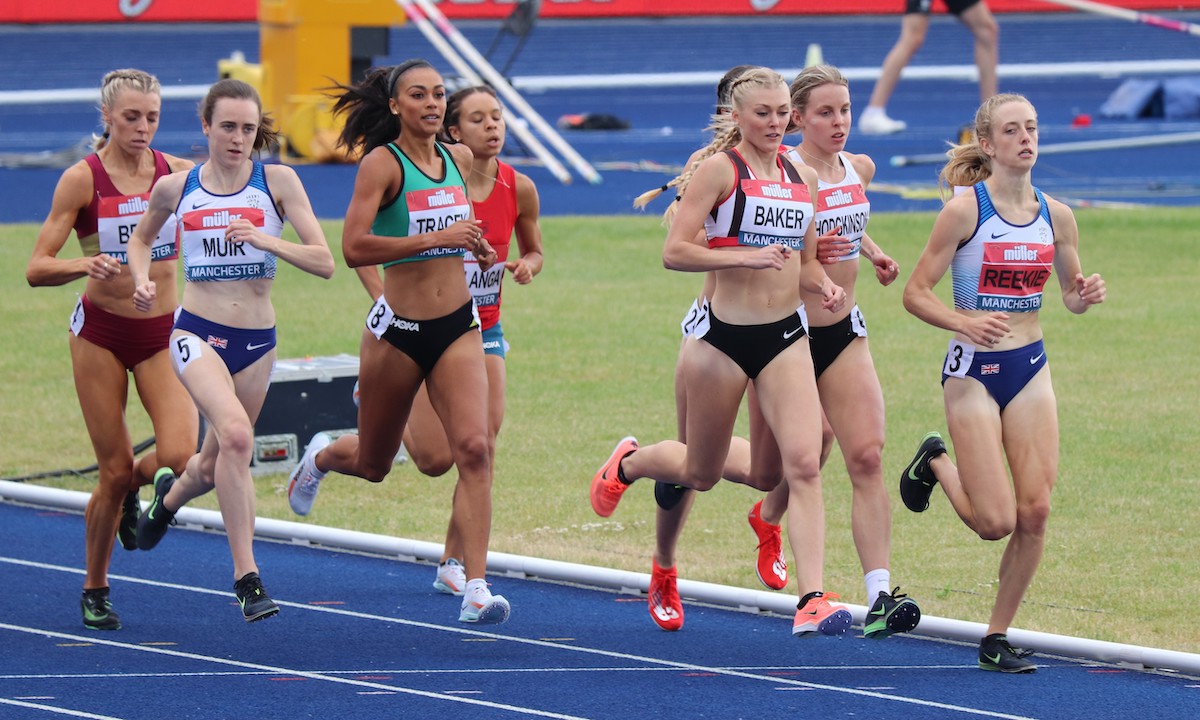

Featured
What Is Seed In Track And Field
Modified: January 2, 2024
Learn all about the concept of seed in track and field competitions. Explore how it influences the placement and performance of featured athletes.
Introduction
Track and field is a sport that encompasses a wide range of athletic disciplines, from sprints and long jumps to shot put and javelin throws. Within the world of track and field, the concept of seed holds significant importance. Seed refers to the predetermined position or ranking assigned to athletes or teams before a competition begins. It plays a crucial role in determining the race schedule and can greatly impact an athlete’s strategy and performance.
Seeding in track and field competitions is not a random process. It involves careful consideration of various factors, such as previous performance records, personal best times, and recent achievements. The goal is to create a fair and competitive environment where athletes of similar abilities and skill levels are grouped together.
Understanding the importance of seed in track and field is essential for athletes, coaches, and spectators alike. A favorable seed can provide athletes with a strategic advantage, allowing them to compete against opponents who are at a similar level. It can also influence the race schedule, ensuring that the most competitive matchups occur later in the competition.
In this article, we will delve deeper into the concept of seed in track and field. We will explore the factors considered when determining seed, the role it plays in race scheduling, and strategies that athletes can employ to improve their seed position. Let us now uncover the intricacies of seed in track and field competitions and its significance in shaping the outcome of events.
Seed in Track and Field: An Overview
Seed in track and field refers to the process of assigning athletes or teams a predetermined position or ranking before a competition begins. It acts as a way to organize and group participants based on their skill levels and previous performance records. With a clear seeding system in place, athletes can compete against others who are at a similar level, creating a fair and competitive environment.
The seed is typically determined by considering various factors, including an athlete’s personal best times, recent achievements, and past performance records. By analyzing these factors, competition organizers can ensure that athletes of similar abilities are grouped together, increasing the chance of exciting and closely contested races.
Seeding is particularly important in track and field because of the wide range of events and disciplines within the sport. Each event requires different skills and abilities, and it is crucial to place athletes in appropriate groups based on their strengths and weaknesses. This process helps to level the playing field and reduces the likelihood of a significant skill disparity between competitors.
Seed also plays a significant role in determining the race schedule of track and field competitions. Athletes with higher seeds are often placed in later heats or races, allowing for more anticipation and excitement as the competition progresses. The race schedule is carefully constructed to ensure that the most elite and closely matched athletes compete against each other in the final stages of the competition.
Furthermore, seed can impact an athlete’s strategy and performance. Athletes with a higher seed may approach their race with more confidence, knowing that they are among the top competitors. Conversely, athletes with a lower seed may strive to outperform their expectations and prove their abilities against tougher opponents.
In summary, seed in track and field is the method of assigning a pre-determined position or ranking to athletes or teams before a competition. It helps to organize and group participants based on their skill levels, ensuring fair and competitive matchups. By considering various factors, such as personal best times and recent accomplishments, organizers can create a race schedule that enhances excitement and allows athletes to showcase their abilities. Seed plays a crucial role in shaping the outcome of track and field events and is a fundamental part of the sport.
Importance of Seed in Track and Field Competitions
The seed position in track and field competitions holds immense importance for athletes, coaches, and spectators alike. It plays a crucial role in creating fair and competitive matchups, influencing race strategies, and adding excitement to the overall event.
One of the key reasons why seed is important is that it ensures athletes compete against opponents of similar abilities. By grouping athletes based on their performance records, personal bests, and recent achievements, the seed system helps to level the playing field. Athletes are more likely to face competitors who are at a similar skill level, which results in more exciting and closely contested races. This fairness in competition adds to the overall integrity and credibility of track and field events.
Seed position also impacts the race schedule, making it a vital component of track and field competitions. Athletes with higher seeds are often placed in later heats or races, allowing for anticipation and excitement to build throughout the event. This strategic scheduling boosts the spectator experience, as audiences get to witness the most elite and closely matched athletes compete against each other at the pinnacle of the competition. It creates a thrilling finale for both athletes and spectators alike.
Furthermore, the seed position can significantly influence an athlete’s race strategy. Athletes with a higher seed may approach their race with confidence and assertiveness, knowing that they are considered among the top competitors. This self-assurance can lead to more strategic and aggressive race tactics, as these athletes strive to maintain their position or improve it further.
On the other hand, athletes with a lower seed have the opportunity to surpass expectations and prove their abilities against tougher opponents. They may adopt a more calculated approach, conserving their energy in the preliminary rounds to unleash their full potential in the later stages of the competition. This underdog mentality can often lead to remarkable and inspiring performances, capturing the attention and admiration of both spectators and fellow competitors.
In summary, the importance of seed in track and field competitions cannot be overstated. It ensures fair and competitive matchups, influences race strategies, and adds excitement to the overall event. By grouping athletes based on their abilities, organizers create an environment where athletes can showcase their skills against opponents who are at a similar level. Additionally, the strategic race scheduling based on seed position enhances the spectator experience, making it a crucial factor in the success of track and field competitions.
Factors Considered in Determining Seed
Determining the seed position in track and field competitions involves careful consideration of various factors. These factors help organizers create a fair and competitive environment by grouping athletes based on their abilities and previous performances. Let’s explore some of the key factors that are typically considered when determining seed.
- Personal Best Times: One of the primary factors considered is an athlete’s personal best time in the specific event. This metric provides insight into an athlete’s potential and serves as a benchmark for their performance. Athletes with faster personal best times are generally given higher seeds, as they are expected to be among the top contenders in the competition.
- Recent Achievements: Organizers also take into account an athlete’s recent achievements, such as winning regional or national competitions or setting new records. These accomplishments demonstrate an athlete’s current form and competitiveness, influencing their seed position. Impressive recent achievements can earn athletes a higher seed, allowing them to compete against other top performers.
- Performance Records: The overall performance records of athletes are another factor considered in determining seed. This includes reviewing an athlete’s performance in previous competitions, taking note of their consistency and ability to perform well under different conditions. A strong performance record can boost an athlete’s seed, reflecting their proven track record of success.
- Head-to-Head Results: In some cases, head-to-head results against specific competitors may also be taken into account. If an athlete has consistently outperformed certain opponents in previous meetings, it can influence their seed position, particularly when the competition involves a limited number of top competitors.
- Rankings: Rankings provided by official governing bodies or sporting associations may be considered when determining seed. These rankings are typically based on a combination of an athlete’s performance records and recent achievements, providing a comprehensive assessment of the athlete’s standing in their respective event. Athletes with higher rankings are often given higher seeds.
It is important to note that the specific weight assigned to each factor may vary depending on the specific competition and the preferences of the organizers. The ultimate goal is to group athletes in a way that creates a fair and competitive environment, ensuring exciting and closely contested races.
In summary, the factors considered in determining seed position involve a comprehensive evaluation of an athlete’s personal best times, recent achievements, performance records, head-to-head results, and rankings. By considering these factors, organizers can create a seed system that accounts for an athlete’s abilities and provides a fair and competitive environment for track and field competitions.
Role of Seed in Race Scheduling
The seed position plays a vital role in the race scheduling of track and field competitions. It helps organizers create an engaging and strategically planned event that maximizes excitement and competitiveness. Let’s explore the key roles that seed plays in race scheduling.
One of the primary roles of seed in race scheduling is to ensure that the most competitive and closely matched matchups occur at the later stages of the competition. Athletes with higher seeds are typically placed in later heats or races, allowing the anticipation and excitement to build as the event progresses. This strategic scheduling keeps the audience engaged and invested in the competition, as they get to witness the best athletes compete against each other in thrilling final races.
Race scheduling based on seed also helps in maintaining the integrity of the competition. By grouping athletes of similar abilities together, organizers minimize the chance of significant skill disparities between competitors. This approach ensures that each race is competitive and closely contested, contributing to the fairness and credibility of the event.
Furthermore, race scheduling influenced by seed allows athletes to showcase their abilities on the biggest stage. Athletes with higher seeds are given the opportunity to compete in prime time slots, where they can attract more attention from spectators, media, and potential sponsors. This exposure can further motivate athletes to perform at their best and create memorable moments in the sport.
Seed-based race scheduling also considers logistical factors, such as the number of available lanes or starting blocks, to optimize the flow of the competition. Organizers strive to minimize delays and provide athletes with the best possible conditions for their race. By factoring in seed position, they can effectively plan the race schedule to ensure smoother transitions between events and minimize interruptions due to lane assignments or equipment adjustments.
Ultimately, the role of seed in race scheduling is to enhance the overall experience for athletes and spectators alike. By strategically placing top contenders in later stages of the competition, maintaining competitive matchups, and optimizing logistical aspects, organizers can create a captivating and well-executed track and field event.
In summary, seed plays a pivotal role in race scheduling within track and field competitions. It ensures that the most competitive matchups occur at the later stages, maintaining the excitement and engagement of the audience. Race scheduling based on seed also contributes to the integrity of the competition, minimizes skill disparities, and provides athletes with optimal conditions to showcase their abilities. The careful consideration of seed in race scheduling is crucial for creating a memorable and well-organized track and field event.
Examples of Seed in Track and Field Events
The concept of seed is prevalent in various track and field events, with different competitions and tournaments implementing seed positions to create fair and competitive matchups. Let’s explore some examples of how seed is utilized in track and field events.
In a track event such as the 100-meter dash, seed positions are assigned to athletes based on their personal best times. The fastest athletes are generally given higher seeds, placing them in later races and heats. This ensures that the top contenders have the opportunity to compete against each other in the final stages of the event. This scheduling builds anticipation and excitement, as spectators eagerly await the showdown between the fastest sprinters.
In distance races, such as the 1500 meters or the 5000 meters, seed positions are determined by a combination of factors that include an athlete’s current form, past performance records, and rankings. This helps to group athletes of similar abilities together, ensuring competitive races throughout the event. By carefully considering seed positions, organizers can create exciting races where athletes push each other to achieve their best performances.
Field events also utilize seed positions to create fair and competitive matchups. In disciplines such as the long jump or high jump, athletes are seeded based on their personal best distances or heights. The best performers are assigned higher seeds, enabling them to compete in later rounds against other top competitors. This setup allows for intense rivalries and showcases the skill and technique required in these event categories.
Another example of seed utilization can be seen in relay races. Whether it’s the 4×100-meter relay or the 4×400-meter relay, teams are seeded based on their overall performance records and recent achievements. Teams with faster combined times or impressive relay performances are given higher seeds, ensuring that they compete against each other at later stages of the competition. This scheduling creates thrilling and closely contested relays, with each team vying for the top positions.
It’s important to note that the specific criteria for determining seed positions may vary from one competition to another. Some competitions may prioritize recent achievements and world rankings, while others may focus solely on personal best times. The objective is always to create fair and competitive matchups that showcase the talents of the athletes and provide an entertaining spectacle for spectators.
In summary, seed positions are utilized in a wide range of track and field events, including sprints, distance races, field events, and relays. Athletes are assigned seed positions based on factors such as personal best times, recent achievements, and overall performance records. By carefully considering these factors, organizers can create fair and competitive matchups, pitting top athletes against each other in thrilling races and events.
Strategies for Improving Seed Position
Improving seed position in track and field competitions can provide athletes with a strategic advantage, allowing them to compete against opponents who are at a similar skill level. Here are some effective strategies athletes can employ to enhance their seed position.
1. Focused Training: Athletes can improve their seed position by focusing on specific areas that need improvement. This could involve targeted training sessions to enhance speed, endurance, technique, or strength, depending on the requirements of their event. By identifying and addressing weaknesses, athletes can improve their performance and achieve better results, leading to a higher seed position.
2. Consistency and Performance: Performing consistently well in competitions is crucial to improving seed position. Athletes should aim to consistently achieve their personal best times or distances and strive for podium finishes. Consistent strong performances demonstrate an athlete’s competitiveness and can result in a higher seed position for future competitions.
3. Participation in Higher-Level Events: Competing in higher-level events can provide opportunities to face stronger opponents and set faster times or better marks. These performances in top-tier competitions can significantly impact an athlete’s seed position. By seeking out opportunities to compete against elite competition, athletes can showcase their abilities and earn a higher seed position for future events.
4. Effective Race Tactics: Employing strategic race tactics can play a vital role in improving seed position. Athletes should analyze their opponents and plan their race strategy accordingly. This may involve conserving energy in preliminary rounds to unleash a strong finish in later rounds or utilizing different pacing strategies to gain an edge over competitors. A well-executed race strategy can result in improved performances and a higher seed position.
5. Continuous Self-Development: Athletes should constantly seek opportunities for self-improvement by working with coaches, analyzing performances, and seeking feedback. Making necessary adjustments and learning from past experiences can lead to better performances and a higher seed position. Athletes should embrace a growth mindset and continuously strive to enhance their skills and abilities.
6. Consistent Training and Recovery: Consistency in training and proper recovery play a vital role in improving performance and seed position. Athletes should maintain a disciplined training regime, ensuring they are consistently putting in the required effort and following their training plans. Additionally, giving equal importance to recovery, including rest periods and proper nutrition, helps minimize the risk of injuries and optimize performance during competition.
7. Track and Utilize Performance Metrics: Utilizing performance metrics, such as personal best times or distances, can provide valuable insights into an athlete’s progress. By tracking and analyzing these metrics, athletes can set achievable goals and monitor their improvement over time. This data can motivate and guide athletes as they work towards improving their seed position.
In summary, improving seed position in track and field competitions requires a combination of focused training, consistent performance, effective race tactics, continuous self-development, and proper training and recovery. By implementing these strategies, athletes can enhance their abilities, achieve better results, and earn higher seed positions, creating favorable opportunities for success in future competitions.
Conclusion
Seed position in track and field competitions plays a vital role in shaping the dynamics of the events. It ensures fair and competitive matchups, influences race scheduling, and provides athletes with strategic advantages. The determination of seed is based on factors such as personal best times, recent achievements, performance records, and rankings. By considering these factors, organizers can create a system that groups athletes of similar abilities together, resulting in exciting and closely contested races.
The role of seed extends beyond just assigning rankings. It influences the race scheduling, placing top contenders in later stages to build anticipation and provide thrilling finale races. Seed position also affects an athlete’s race strategy, with higher seeded athletes approaching their races with confidence, while lower seeded athletes strive to outperform expectations.
Athletes can employ various strategies to improve their seed position, such as focused training, consistent performances, effective race tactics, continuous self-development, and proper training and recovery. By implementing these strategies, athletes can enhance their skills, achieve better results, and earn higher seed positions, giving them an advantage in future competitions.
In conclusion, seed in track and field is a crucial aspect of the sport. It ensures fair competition, influences race scheduling, and provides athletes with strategic advantages. By understanding the significance of seed and employing effective strategies, athletes can enhance their performance and increase their chances of success in track and field competitions.









